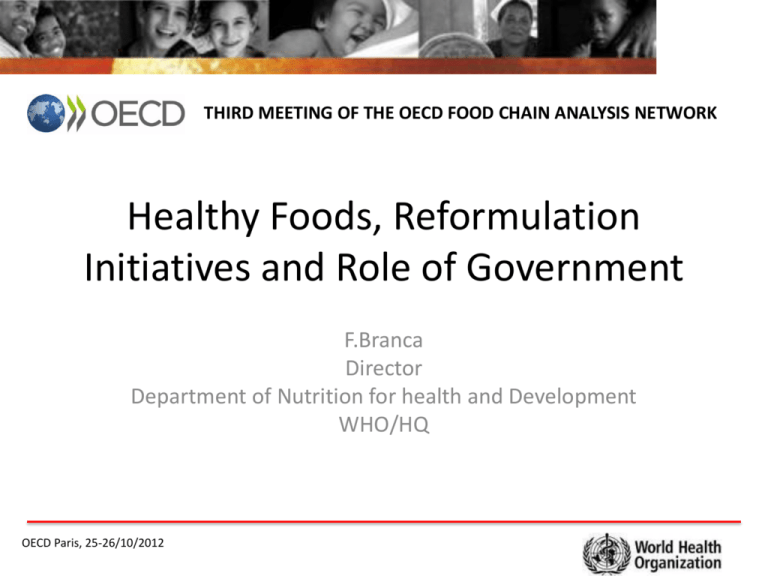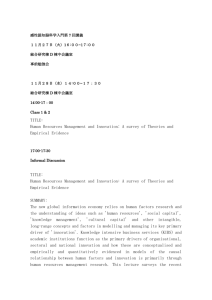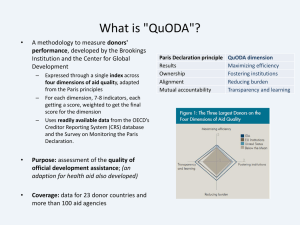Healthy Foods, Reformulation Initiatives and Role of
advertisement

THIRD MEETING OF THE OECD FOOD CHAIN ANALYSIS NETWORK Healthy Foods, Reformulation Initiatives and Role of Government F.Branca Director Department of Nutrition for health and Development WHO/HQ OECD Paris, 25-26/10/2012 Questions for panel II • What public and private initiatives for the production and marketing of healthy foods? • What innovations and reformulations of foods are underway to increase the healthy food options? • Is there a role for governments in providing for the production of healthy foods? OECD Paris, 25-26/10/2012 Healthy foods OECD Paris, 25-26/10/2012 Ranges of population nutrient intake goals (WHO/FA0, 2003) OECD Paris, 25-26/10/2012 Global Strategy on Diet, Physical Activity and Health (2004) 1. Reducing trans fatty acids and salt 2. Restricting availability of energy dense foods and high calorie non-alcoholic beverages 3. Increasing availability of healthier foods including fruits and vegetables 4. Practice of responsible marketing to reduce impact of unhealthy foods to children 5. Making healthy options available and affordable 6. Providing simple, clear and consistent food labels that are consumer friendly 7. Reshaping industry to introduce new products with better nutritional value 8. Making physical activity accessible in all settings OECD Paris, 25-26/10/2012 "Best buys" interventions to address NCDs Populationbased interventions addressing NCD risk factors Tobacco use Harmful use of alcohol Unhealthy diet and physical inactivity - Excise tax increases Smoke-free indoor workplaces and public places Health information and warnings about tobacco Bans on advertising and promotion Excise tax increases on alcoholic beverages Comprehensive restrictions and bans on alcohol marketing Restrictions on the availability of retailed alcohol - Salt reduction through mass media campaigns and reduced salt content in processed foods Replacement of trans-fats with polyunsaturated fats Public awareness programme about diet and physical activity IndividualCancer based interventions addressing NCDs in primary care Cardiovascular disease and diabetes - Prevention of liver cancer through hepatitis B immunization Prevention of cervical cancer through screening (visual inspection with acetic acid [VIA]) and treatment of precancerous lesions - Multi-drug therapy (including glycaemic control for diabetes mellitus) for individuals who have had a heart attack or stroke, and to persons at high risk (> 30%) of a cardiovascular event within 10 years Providing aspirin to people having an acute heart attack - OECD Paris, 25-26/10/2012 Proposed Indicators NCD Global monitoring and targets for 2025 for the global monitoringand framework for NCDs framework Targets indicators Mortality between ages 30 and 70 due to CVD, cancer, diabetes, and chronic respiratory disease Indicators with targets 25% reduction Hypertension Tobacco Salt Physical inactivity 25% reduction 30% reduction 30% reduction 10% reduction Overweight/obesity (adult, child, adolescent) Raised total cholesterol Other Raised blood glucose/diabetes WHO Adult per capita consumption of alcohol and heavy core episodic drinking indicators Policies to virtually eliminate trans fats and to reduce marketing of unhealthy foods to children Cervical cancer s creening Vaccination: HPV, Hepatitis B Access to basic technologies and medicines Low fruit and vegetable intake Access to palliative care Cancer incidence, by type Multidrug therapy for CVD risk reduction Other country-specific indicators of NCD and related issues including social determinants of health * All indicators should be disaggregated by gender, age, socioeconomic position, and other relevant stratifiers OECD Paris, 25-26/10/2012 Food reformulation initiatives OECD Paris, 25-26/10/2012 Salt reduction in the UK 2003 : 3 pronged strategy – campaign to raise awareness – targets for food industry to reduce salt levels in 80 food categories – front of pack labelling 2008 : 26,000 t/y salt removed • 24h urinary sodium in a random sample of adults has decreased 10% (from 9.5 to 8.6 g/d salt) • ≈ 6000 deaths/yr - strokes, heart attacks saved 2010: ↓20-40% in processed food products OECD Paris, 25-26/10/2012 Setting Guiding Benchmark Sodium Reduction Levels for Processed Foods (Canada) http://www.hc-sc.gc.ca/fn-an/nutrition/sodium/sodium-intake-apport-reduction/summarytable-tableau-sommaire-eng.php OECD Paris, 25-26/10/2012 Salt reduction in catering (USA) Targets to guide company reductions in the salt levels in 25 categories of restaurant food. The initiative includes voluntary 2012 and 2014 targets for average salt levels in each food category as well as a maximum salt level for all items served in restaurants. When a restaurant signs on to the initiative, it pledges that its overall sales in a given category – cheeseburgers, for example – will meet the relevant target for salt content, even if some individual products don't. OECD Paris, 25-26/10/2012 TFA reduction in New York City 2007 regulation : restricts from using, serving, storing, serving foods that contains PHVO and has a total 0.5 g or more TFA per serving Angell et al. Ann Intern Med 2012;157:81-86 OECD Paris, 25-26/10/2012 Australia – food category action plan • To achieve the overall objective of reducing sodium and saturated fat in processed meats, participants have agreed to: – reduce the sodium content of nominated bacon2 and ham/cured meat products to 1090mg per 100g. – reduce the sodium content of nominated emulsified luncheon meats3 to 830mg per 100g. – reduce by 10 per cent the saturated fat content of nominated cooked/smoked sausages4 and emulsified luncheon meats that have in excess of 6.5g of saturated fat per 100g. • The timeframe for action will be 1 January 2010 to 31 December 2013. The products targeted and the amount of sodium and saturated fat to be removed from products each year will be determined by the individual companies involved. OECD Paris, 25-26/10/2012 Potential impact of “my choice” program on key nutrient intake Nutrient WHO Dutch Menu My Choice Menu Energy 2000-2500 kcal 2421 kcal 2058 kcal Saturated fat <10 E% 10.9 E% 7.1 E% Trans fat <1 E% 0.4 E% 0.1 E% Free sugars <10 E% 19.1 E% 7.8 E% Fiber >25 g 27 g 38 g Sodium <2400 mg 3579 mg 2773 mg Jansen L. VOEDING NU 2007; 4:21-23 OECD Paris, 25-26/10/2012 Role of governments OECD Paris, 25-26/10/2012 Current food policy environment Hawkes, BMJ 2012; 344:e2801 OECD Paris, 25-26/10/2012 Consumer purchases with traffic light food labelling of nutrients as proposed by UK's Food Standards Agency Wheel of Health (WoH) JS Ham and Pineapple Pizzeria 356g all 5 GREEN on WoH 'Be Good to Yourself' Chocolate sponge puddings 4 Green, 1 amber 42% 55% 42% 89% JS Ham & Pineapple Thin & Crispy Pizza 335g 1 red, 2 amber, 2 green Sainsbury's Supermarket presentation to The National Heart Forum, UK., 2006. 'Taste the Difference' Melting Middle Chocolate puddings 4 red, 1 amber Evidence of the impact of advertising regulations Quebec (1980) •Between 7.1% and 9.3% drop in the probability of purchasing fast food •Annual drop of between 11 million and 22 million fast-food meals Baylis & Dhar (2007) UK (2008) • Children aged 4–9 saw 52% less advertisement on unhealthy food • Children aged 10–15 saw 22% less advertisement on unhealthy food Ofcom (2010) France (2004) • 21% of individuals above age 15 changed their eating habits • 17% of individuals above age 15 changed their food-purchasing habits Ministère de la santé de la jeunesse et des sports (2008) OECD Paris, 25-26/10/2012 Population approached to improve diet recommended by the American Heart Association • Sustained, focused media and educational campaigns, using multiple modes, for increasing consumption of specific healthful foods or reducing consumption of specific less healthful foods or beverages as part of multicomponent strategies (I B) • Multicomponent school interventions (I A) • Subsidy strategies to lower prices of more healthful foods and beverages (I A) • Restriction of TV advertisement (I B) • Regulatory policies to reduce specific nutrients in foods (I B) Mozaffarian et al. Circulation 2012;126:1514-1563 OECD Paris, 25-26/10/2012








